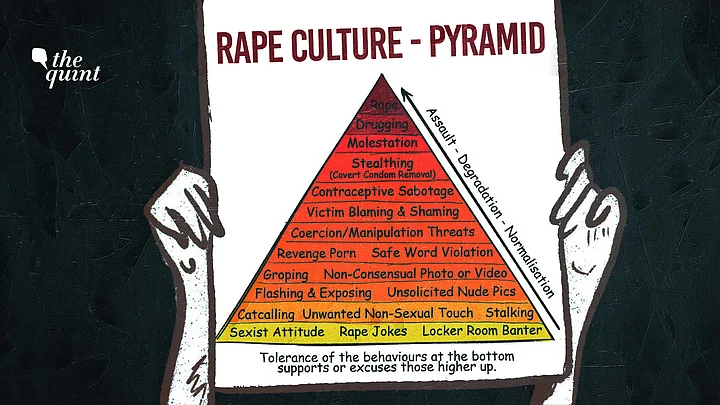(This story was first published on 8 May 2020. It has been republished from The Quint’s archives in light of the Supreme Court asking a rape accused if he will marry the survivor.)
Every time an act of sexual violence comes to the notice of the public, the question that is probably not asked enough – why do we find ourselves here again? Why are acts of sexual violence, rape against the vulnerable – women and men and those who identify as non-binary – so common, that they are almost normal? It is because we live in an environment that allows this to be normal. Taking the example of just women and the violence they face, we break down rape culture and how it builds to form a pyramid of sexual harassment and violence.
WHAT IS RAPE CULTURE?
It is an environment in which rape is prevalent and sexual violence is normalised because of the existing societal prejudices and attitudes towards gender and sexuality.
NORMALISING RAPE CULTURE
These prejudices show up in the form of victim-blaming and slut-shaming, questioning their motives and their integrity, instead of the perpetrators’. Normalising objectification of women’s bodies in pop culture, trivialising sexual assault to even glamourising it, these are all behaviours that lead to society where women’s rights and safety are not a priority. Rape culture is often the reason survivors don’t report their assault. It squarely puts the responsibility of women’s safety on women, almost absolving the perpetrators of their crimes.
NORMALISATION - DEGRADATION - ASSAULT
The rape culture pyramid that you see below shows how behaviours, beliefs and systems are built in conjunction with one another. The tolerance of behaviour at each level supports or excuses the behaviour at the next level. The normalisation of sexist behaviour like locker room banter, rape jokes lead to catcalling, stalking, which can lead to unsolicited nudes which then leads to degradation of the victim through groping, safe-word violation, coercion and manipulation, victim-blaming and shaming, ultimately leading to assault – molestation, drugging, rape and in many cases, murder.
Why is it important to understand this pyramid? Because, often when we talk about solutions to end sexual violence and sexual assault, we are looking at only the top of the pyramid, when it is being supported by a chain of behaviours and activities. It is equally important to look at the bottom half of the pyramid and to bring about a real behavioural shift and prevention.
(At The Quint, we question everything. Play an active role in shaping our journalism by becoming a member today.)
